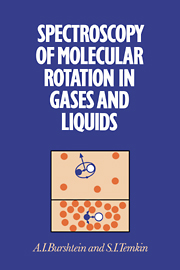Book contents
- Frontmatter
- Contents
- 0 Introduction
- 1 Rotational relaxation
- 2 Orientational relaxation in dense media
- 3 Transformation of isotropic scattering spectra
- 4 Quantum theory of spectral collapse
- 5 Rotational relaxation: kinetic and spectral manifestations
- 6 Impact theory of orientational relaxation
- 7 Rotation and libration in a fluctuating cell
- Appendix 1
- Appendix 2
- Appendix 3
- Appendix 4
- Appendix 5
- Appendix 6
- Appendix 7
- Appendix 8
- Appendix 9
- References
- Index
7 - Rotation and libration in a fluctuating cell
Published online by Cambridge University Press: 06 November 2009
- Frontmatter
- Contents
- 0 Introduction
- 1 Rotational relaxation
- 2 Orientational relaxation in dense media
- 3 Transformation of isotropic scattering spectra
- 4 Quantum theory of spectral collapse
- 5 Rotational relaxation: kinetic and spectral manifestations
- 6 Impact theory of orientational relaxation
- 7 Rotation and libration in a fluctuating cell
- Appendix 1
- Appendix 2
- Appendix 3
- Appendix 4
- Appendix 5
- Appendix 6
- Appendix 7
- Appendix 8
- Appendix 9
- References
- Index
Summary
It was demonstrated in Chapter 6 that impact theory is able to describe qualitatively the main features of the drastic transformations of gas-phase spectra into liquid ones for the case of a linear molecule. The corresponding NMR projection of spectral collapse is also reproduced qualitatively. Does this reflect any pronounced physical mechanism of molecular dynamics? In particular, can molecular rotation in dense media be thought of as free during short time intervals, interrupted by much shorter collisions?
It seems that an affirmative answer is hardly possible on the contemporary level of our general understanding of condensed matter physics. On the other hand, it is necessary to find a reason for numerous successful expansions of impact theory outside its applicability limits.
One possibility for this was demonstrated in Chapter 3. If impact theory is still valid in a moderately dense fluid where non-model stochastic perturbation theory has been already found applicable, then evidently the ‘continuation’ of the theory to liquid densities is justified. This simplest opportunity of unified description of nitrogen isotropic Q-branch from rarefied gas to liquid is validated due to the small enough frequency scale of rotation–vibration interaction. The frequency scales corresponding to IR and anisotropic Raman spectra are much larger. So the common applicability region for perturbation and impact theories hardly exists. The analysis of numerous experimental data proves that in simple (non-associated) systems there are three different scenarios of linear rotator spectral transformation.
- Type
- Chapter
- Information
- Spectroscopy of Molecular Rotation in Gases and Liquids , pp. 224 - 257Publisher: Cambridge University PressPrint publication year: 1994



